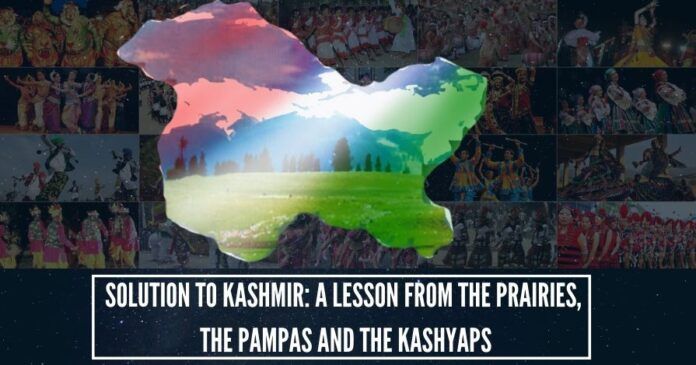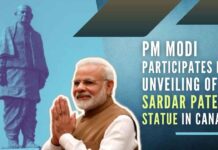
There is a pointer in the recent history of the Prairies and the Pampas that the government of India can use to integrate, to the extent the majority of the population in India desires, Kashmir with India. The pointer is derived from a comparison of the incentives of immigration in two economies, the United States and Argentina, that were rivals in the late 18th and early 19th centuries.
Dr. Subramanian Swamy advocates an approach of encouraging ex-military men to settle in Kashmir, the reason being that the men are already trained in combat and can protect themselves, and the people they live around.
The U.S. government, during the period, had the landownership essentially democratized; any immigrant who seized a specified maximum area of land had the property rights to the land acknowledged by the government. When the news spread, aspiring farmers from around the world started pouring in and by 1850, the U.S. was pulling in close to 250,000 immigrants annually. In contrast, during the same period, the government in Argentina, which until the early 1900s was considered an economy equal to, if not bigger than, the U.S., followed a heavy-handed approach and sold large plots of land, leaving aspiring small families with little or no incentive to immigrate. Only rich landlords bought the land and later realized that they had no labor to work on it. It is believed that this difference in incentives of immigration played its part in making farming in the U.S. much more productive than in Argentina. This difference also points to an approach that the government of India can adopt to address the problem of domestic migration in Kashmir.
Dr. Subramanian Swamy advocates an approach of encouraging ex-military men to settle in Kashmir, the reason being that the men are already trained in combat and can protect themselves, and the people they live around, relieving the government of the resources it needs to protect the residents. This approach can be complemented by the economic incentives of the Prairies. Majority of the military men in India come from farming families. If the title to the land of their choosing is granted by the government, these men and their families can put their farming skill-sets to use. If the government follows the heavy-handed Pampas approach of applying its own mind in selecting the plots of land to distribute, it will inevitably trap itself in the pretense of knowledge.
Relying on the vast knowledge base of immigrants is the approach of the Prairies. This can take various forms; a Kashmiri Pandit, who can find, an ex-military person to settle with her/him, can partner and move in. A Sardar with an unemployed son, and means to defend himself, can move in. A small farmer in Bihar who learns about it in Mann Ki Baat, and dreams of having his own land one day, can move in. With relaxed gun control rights in Kashmir, for the Kashmiri Pandit, the soldier, the Sardar, and the dreamer from Bihar, to be able to defend themselves, this strategy rooted in the Risk-Reward system has the potential to integrate the people of Kashmir with India.
It is for the legal experts to decide whether Article 370 is a roadblock; how many Articles of the South were violated in the American Civil War not long ago? Another roadblock and the more formidable one is the army of bureaucrats in India that wants everything to be under their control and can think of nothing but wise-ass tricks to treat the symptoms, and not the disease. If Modi can overcome these two roadblocks, he can solve the Kashmir Problem and have this under his belt.
Note:
1. The views expressed here are those of the author and do not necessarily represent or reflect the views of PGurus.
- Solution to Kashmir: A Lesson From The Prairies, the Pampas and the Kashyaps - February 12, 2019
- Kartavya,Adhikaar And Skill. A Worthy recipient of Skill India Scheme? - October 16, 2017
- Demonetization Has Opened A Window Of Opportunity For Modi - December 21, 2016











I totally agree with this approach. Forget article 370, which is being used to twist Indiana’s arms.
To begin with, the refugee kashmiri Pandits could be given first preference, specific areas of Kashmir should be cordoned off and civilians can then move. However I do not agree that these people should be left at the mercy to take care but f themselves. US in the 18th and 19th century is very different from what violence these people will face. Follow what Israel is doing. People backed by military.
The U.S. in the 19th century was the wild west, probably worse than what we have in Kashmir. Arms-bearing residents can complement the limited resources of the police and the army in Kashmir. To describe it by saying ‘left at the mercy’ is to assume that Indians, even when armed, need a nanny to protect them. Indian politicians and bureaucrats are afraid to let people experience the rugged individualism on which the west was founded.
It is nice of Shuvendu that he has reacted to shri Krisnamurthy in most matured way. If given opportunity, many a Indians will love to migrate and settle in kashmir. Article 370 stops them to do so. It is for the Govt. to make article 370 defunct which was as such made for a limited period but being continued for vote bank politics. Let us all vote overwhelmingly with 2/3 rd majority so that many a ills in the country can be taken care of. are we ready for the same?
Mr. Krishnamurthy, The beauty of the approach suggested in the article is that it does not force or ask anybody to solve the problem. People, including soldiers, when incentivized, will choose to move to Kashmir.
Subendhu, why don’t you relocate to Kashmir? Why do you folks want only soldiers to solve your problem, while you immigrate after sucking up country’s resources….. A proud Veteran!!